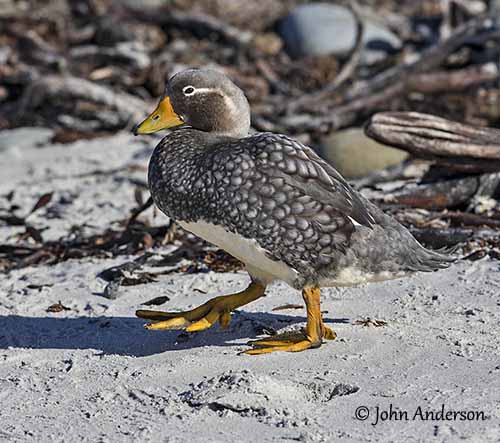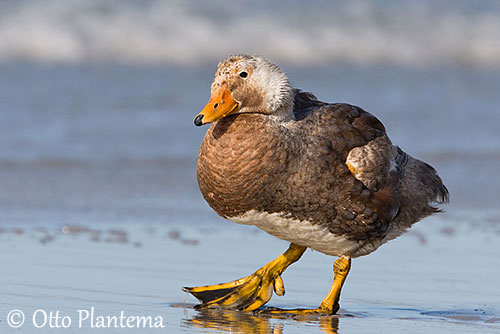
Fr: Brassemer des Malouines
All: Falkland-Dampfschiffente
Esp: Patovapor Malvinero
Ita: Anatra di fiume inetta delle Isole Falkland
Nd: Falklandbooteend
Sd: Kortvingad ångbåtsand
Photographers :
John Anderson
John Anderson Photo Galleries
Otto Plantema
Trips around the world
Text by Nicole Bouglouan
Sources :
HANDBOOK OF THE BIRDS OF THE WORLD vol 1 by Josep del Hoyo-Andrew Elliot-Jordi Sargatal - Lynx Edicions - ISBN: 8487334105
GUIDE DES CANARDS, DES OIES ET DES CYGNES – de Steve Madge - Delachaux et Niestlé - ISBN: 2603013769
BirdLife International (BirdLife International)
Wikipedia, la enciclopedia libre
Falkland Steamerduck
Tachyeres brachypterus
Anseriformes Order – Anatidae Family
INTRODUCTION:
The genus Tachyeres includes four almost similar species, large ducks that have partially lost the power of flight. However, they are able to fly occasionally, often low from water surface, never at great height.
They live close to coastal waters where they walk actively thanks to their powerful legs and feet.
The name of these ducks is closely related to their behaviour in the water. They perform rapid movements across the water, by using the wings in a circular padding motion to propel themselves.

The female has similar body plumage, but she has brown head, white eyering and narrow white curved line behind the eye, extending down on head side. She has greenish-yellow bill.
The juvenile resembles female with dark brown head and neck. The eyering is narrower and the white curved line in lacking. Legs and feet are brownish-yellow. The young male has greyish bill. It will get the bright orange colour at two years old.
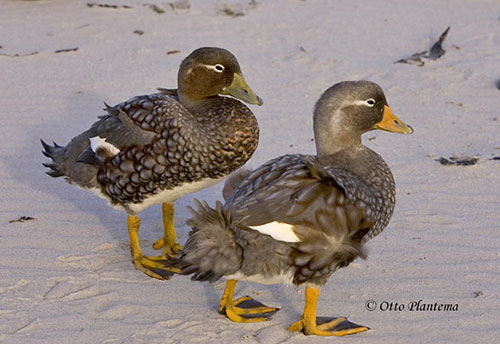
BEHAVIOUR IN THE WILD:
The Falkland Steamerduck feeds on various salt-water molluscs such as mussels and limpets (aquatic gastropod molluscs), and crustaceans such as crabs and shrimps. The shells are crushed with the powerful bill.
It forages near the shore, at water’s edge, by diving and upending in shallow water. Underwater, it uses wings and feet to propel itself. Its feeding behaviour is closely associated with the tides.
During the breeding season, both mates defend the territory situated close to the sea with adjacent area. They favour locations with abundant food resources in sheltered bays and other inshore waters.
The male is very territorial, and fights occur between rivals and neighbours. Strong and bloody battles may occur. The female may also take part, and one of the birds can be killed or heavily injured to death. During these fights, they use the strong spurs of the wings.
The Falkland Steamerduck is usually seen in pairs or family groups along the coasts, but large flocks can be seen all year round, including more than 300 immature birds and non-breeding adults. Some disputes often occur as spring is coming.

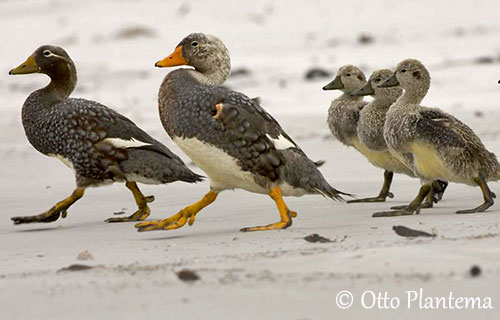
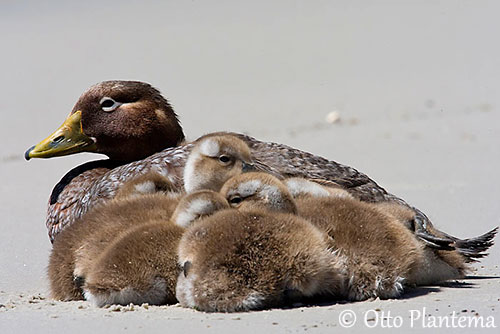
The female lays 5-8 eggs, and incubates alone during 30-34 days. When she leaves the nest for bathing and feeding, the eggs are covered with plant matter to protect them against predators. While the female is incubating, the male patrols the area and chases away the intruders.
The chicks are covered with brownish down above and white below, and show white patches on head sides. They fledge about 12 weeks after hatching. The male takes part in nesting duties except incubation. The chicks are accompanied by the adults and they feed together.

DESCRIPTION OF THE BIRD:
Biometrics:
Length: 61-74 cm
Wingspan: 84-94 cm
Weight: M: 4400 g – F: 3400 g
The Falkland Steamerduck adult male is a large, stocky duck. It has greyish-brown plumage with chestnut-brown edged feathers giving scaled pattern on body. The greyish-brown upperwing shows white secondaries, forming a conspicuous white panel. We can see well-developed orange spurs bare of feathers, at the angle of the wing. The short tail is greyish-brown.
On the underparts, breast, body sides and flanks may show some chestnut tinge. Lower breast, belly and vent are white.
Head and neck are pale greyish, with darker cheeks, and the head usually becomes whiter with the age. The dark eye is surrounded by white eyering, extending in a curved white stripe behind the eye.
The bill is bright orange with black nail. The eyes are dark brown. Strong legs and webbed feet are dark orange-yellow.
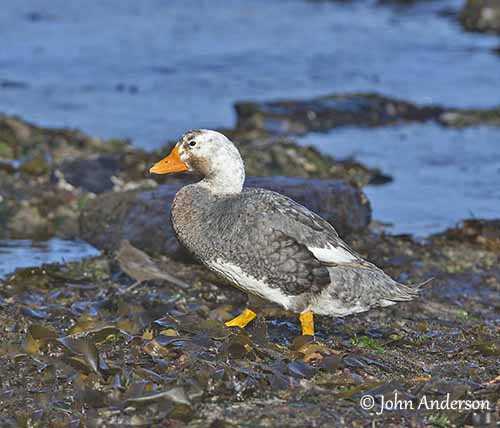
RANGE:
The Falkland Steamerduck is sedentary and endemic to Falkland Islands.
HABITAT:
The Falkland Steamerduck is mainly found in sheltered bays and small islands. This duck frequents rugged rocky coasts.
CALLS AND SONGS: SOUNDS BY XENO-CANTO
The Falkland Steamerduck male gives loud, far-carrying two-note whistle “cheeroo”, and the female produces low grunting and creaking calls. They are noisy birds. However, contact calls are quiet.
The Falkland Steamerduck is sedentary and only performs short-distance flights within Falkland Islands.
This species is almost flightless, but its strong legs and feet are useful when the bird walks on the rocky coasts.
It shows peculiar behaviour on water, using wings and feet to propel itself across the water surface in a rapid padding motion. It performs this among large cloud of spray, while the breast ploughs the water like the prow of a boat.
REPRODUCTION OF THIS SPECIES:
The breeding season varies and eggs can be found almost all the year, with a peak between September and December.
The Falkland Steamerduck breeds in single pairs, usually not far from the water. It nests in tall grass, or in dry kelp tangles, but sometimes in abandoned penguin burrows or among boulders too.
The nest is a shallow depression in the ground, lined with grass and down feathers. It is often near the seashore but sometimes up to 400-1000 metres from the sea. The nest-site is strongly defended by the pair.
